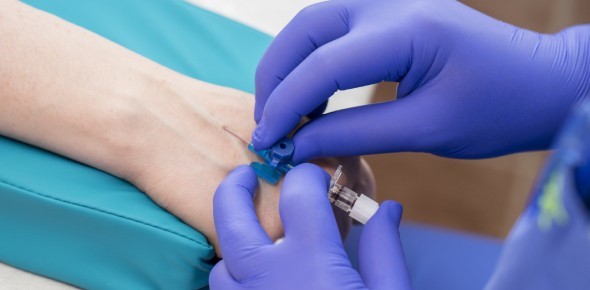A nurse is caring for a client who is hemorrhaging and hypotensive from esophageal variceal bleeding. Which of the following actions should the nurse take first?
Administer vasopressin to the client.
Request blood from blood bank.
Verify that the client has adequate IV access.
Insert an indwelling urinary catheter.
The Correct Answer is C
Verify that the client has adequate IV access.

Choice A rationale:
Administering vasopressin to the client might be necessary to manage the hemorrhage, but before any medication administration, it is crucial to ensure the client has adequate IV access. Vasopressin is a vasoconstrictor and can help control bleeding from esophageal varices, but its effectiveness relies on IV access to deliver the medication promptly.
Choice B rationale:
Requesting blood from the blood bank is essential for a client experiencing significant bleeding. However, the priority action is to verify IV access to administer any necessary blood products.
Choice C rationale:
This is the correct choice. Before initiating any interventions, ensuring the client has appropriate IV access is a priority. Adequate IV access is necessary to administer fluids, medications, or blood products promptly and effectively stabilize the client's blood pressure.
Choice D rationale:
Inserting an indwelling urinary catheter is not the priority action in this situation. While monitoring urine output is important, it should be secondary to addressing the client's hypotension and hemorrhage.
Nursing Test Bank
Naxlex Comprehensive Predictor Exams
Related Questions
Correct Answer is A
Explanation
Answer: A
Rationale:
A) Place the client in a room with negative airflow: Disseminated herpes zoster (shingles) requires airborne precautions because the virus can become aerosolized. A room with negative airflow helps prevent the spread of the virus to other areas, protecting healthcare workers and other patients from infection.
B) Remove isolation gown after leaving the client's room: Isolation gowns should be removed before leaving the client's room to prevent the spread of contaminants to other areas. This intervention is important for infection control but is not specific to the requirement for negative airflow in cases of disseminated herpes zoster.
C) Apply ketoconazole to the lesions three times per day: Ketoconazole is an antifungal medication and is not used for treating herpes zoster, which is caused by a viral infection. Antiviral medications, such as acyclovir, are appropriate for treating herpes zoster lesions.
D) Provide the client with eye protection for ultraviolet B light therapy: Eye protection is necessary during UVB light therapy to protect the eyes, but UVB light therapy is not a standard treatment for disseminated herpes zoster. The priority intervention is to prevent the spread of the infection by using a negative airflow room.
Correct Answer is C
Explanation
Choice A rationale:
Increasing the intake of high-fiber foods is not relevant to managing dry mouth caused by benztropine. While fiber is essential for digestive health, it does not directly address the issue of dry mouth.
Choice B rationale:
Chewing sugarless gum can be helpful in promoting saliva production, but in Parkinson's disease, it can exacerbate swallowing difficulties and increase the risk of aspiration.
Choice C rationale:
Moistening the mouth with lemon-glycerin swabs is the appropriate recommendation. Lemon-glycerin swabs can help lubricate the mouth and provide relief from dryness, which is a common side effect of benztropine, an anticholinergic medication.
Choice D rationale:
Rinsing the mouth with nystatin is used to treat oral candidiasis (thrush), a fungal infection, and is not relevant to managing dry mouth caused by benztropine.
Whether you are a student looking to ace your exams or a practicing nurse seeking to enhance your expertise , our nursing education contents will empower you with the confidence and competence to make a difference in the lives of patients and become a respected leader in the healthcare field.
Visit Naxlex, invest in your future and unlock endless possibilities with our unparalleled nursing education contents today
Report Wrong Answer on the Current Question
Do you disagree with the answer? If yes, what is your expected answer? Explain.
Kindly be descriptive with the issue you are facing.
